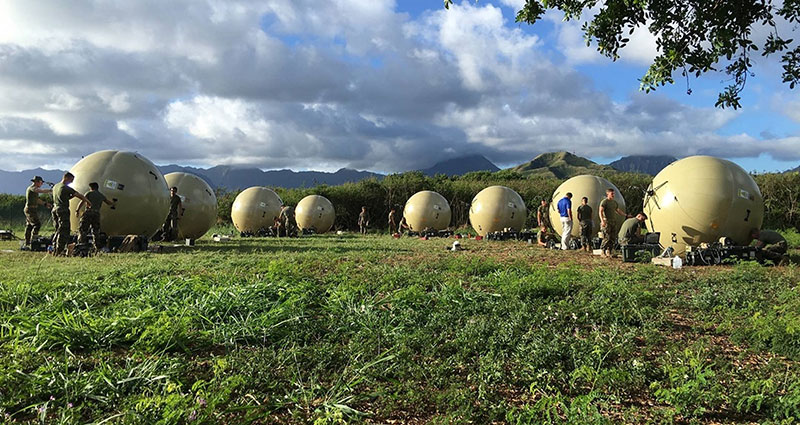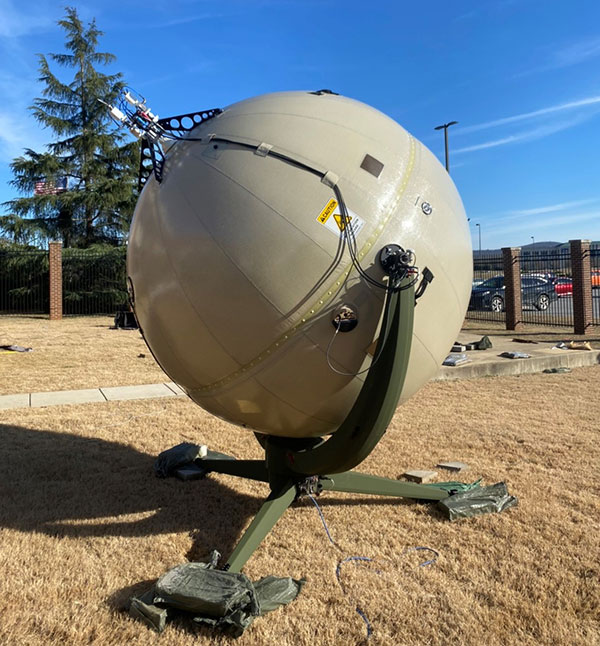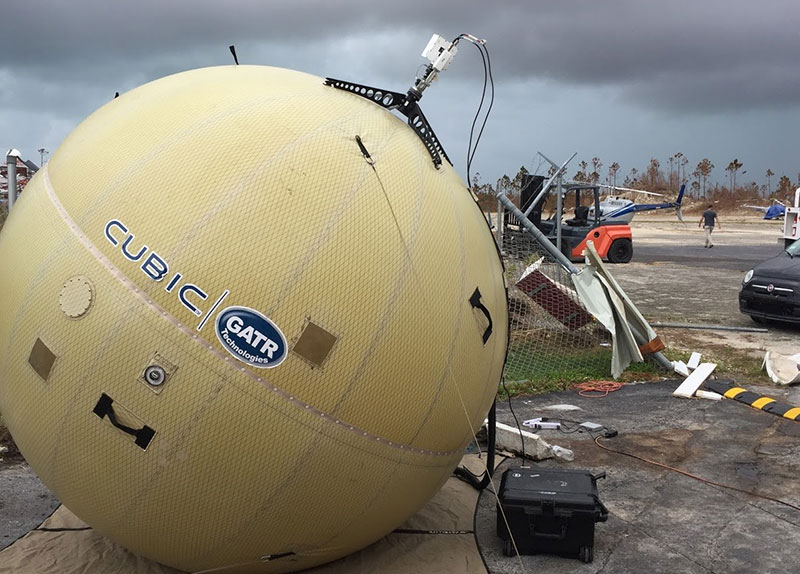 GATR’s inflatable antennas are designed to bring massive throughput to the tactical edge. (Source: Cubic)
GATR’s inflatable antennas are designed to bring massive throughput to the tactical edge. (Source: Cubic)
ALEXANDRIA, Va. — Having a high bandwidth satcom connection is critical for certain expeditionary forces, be they military or emergency first responders. But the more remote personnel get, the more challenging it is to deliver the capabilities without a massive support infrastructure.
Installing a 2.4-meter rigid tracking antenna for a rapid deployment at a temporary location typically requires a cargo pallet or trailer and at least four people to move transit cases, plus the power to operate the tracking motor.
“The problem that our users are having … is they don’t have equipment small enough to get to the tactical edge,” said Bill Meehan, GATR Director of Business Development at Cubic. “That’s the problem we’re solving.”
Cubic Mission and Performance Solutions (CMPS) GATR business is easily recognized for its distinctive inflatable satellite antennas (ISAs) or GATR balls, used primarily by U.S. military and homeland security organizations for two-satcom in remote, austere environments.
The beach ball-looking units inflate to 1.2 meters, 2.4 meters and 4 meters and are designed to optimize SWaP (size, weight and power). Made of a customized fabric with a metallic coating that allow them to reflect radio waves when filled with air, the inflatables have the transmission power of a large antenna with up to 80% less weight and volume than a comparable rigid dish.
Edge ISR Gateway: Turning Hours into Seconds
After deploying an antenna that solved the problem of turning pounds into ounces, Cubic is taking on the challenge of turning hours into seconds in the delivery of commercial ISR imagery to the tactical edge.
“Our intent, ultimately, is to create an edge ISR gateway system that can act like an ISR catcher’s mitt for space-based Earth observation sensors at low Earth orbit and be interoperable with two-way satcom channels,” Meehan explained.
 Cubic has developed a LEO/MEO tracking antenna to provide high-throughput capacity at remote sites. (Source: Cubic)
Cubic has developed a LEO/MEO tracking antenna to provide high-throughput capacity at remote sites. (Source: Cubic)
The system, which is currently under development for the Department of Defense, would incorporate edge compute, ISR data downlink and two-way satcom capabilities at the same site, enabling cloud hosting and the dissemination of real-time intelligence from the tactical edge.
“We’re trying to take the ISR downlink capability from informational only to actionable intelligence,” Meehan said. “That’s the goal…And the technology we have today is capable of all of that.”
Cubic intends to demonstrate its edge ISR capability before the end of the year and is actively seeking opportunities to partner with service providers and potential users.
Improving the Current Model
Right now, the way DoD gets commercial ISR data from sensor to shooter is a lengthy, backward-looking process that can take up to 36 hours from start to finish.
First, a user requests an image or other sensory data of a particular location on Earth. That request is sent through the Commercial GEOINT Access Portal (CGAP). A service provider receives the tasking request and collects the data when one of their available satellites flies overhead. The provider downlinks the data at a commercial ground station, processes it and turns it into a finished ISR product which is delivered electronically to the end user, oftentimes more than a day after the data was initially gathered.
Meehan explained, “What we’re proposing here is to have a capability at the tactical edge, so while the sensor is flying over your head, it takes a picture of something close to you and you still have enough time to downlink that photo, to use it to make tactical decisions.”
Having edge compute platforms at the site of the GATR antennas to maximize the use of its large transport pipelines has been essential. Cubic has been working to improve its suite of edge platforms, servers and network managing tools and has partnered with other companies, including Kratos, to develop a low-SWaP ISR gateway and edge cloud solution.
Mobile Infrastructure for Disaster Response
The military has always been a core user of GATR ISA’sm, given its demand for ruggedized, remote satcom solutions. The inflatables provide infrastructure anywhere at a moment’s notice, linking to satellites in geostationary orbit, tracking LEO and MEO constellations and supportive of C, X, Ku and Ka-band frequencies.
 GATR antennas in action providing real-time support in times of disaster relief assistance. (Source: Cubic)
GATR antennas in action providing real-time support in times of disaster relief assistance. (Source: Cubic)
The company has also been steeped in disaster response and providing rapid support for emergency first responders. GATR started deploying its inflatable antennas to hurricane-ravaged areas in the United States in the early 2000s and continues supporting communications and connectivity for hospitals, police and disaster response units.
“On a yearly basis, we support those disaster response efforts where there is massive communications loss,” explained Nathan Metzger, Cubic’s GATR VP of Business Development. “We’re able to bring GATR antennas in and provide first responders and citizens alike the ability to get on the network, let people know they’re OK, etc.”
In the last several years, Cubic has developed partnerships with organizations interested in using the antennas following emergencies, including the humanitarian support group Global DIRT and the AWS Disaster Response Action Team.
In the future, the company is looking to do more with humanitarian relief and further extend the reach of its solutions into dynamic and airborne sensor tracking, signals intelligence, directed energy and counter-UAS missions.
Explore More:
Satellite Industry Leaders Discuss Cloud Adoption, Evolution of Edge Computing
Where the Bigger Value Add in Geospatial Services: Satellites or Analytics?
Podcast: Virtualization, Cloud and Growth Opportunities for the Teleport
